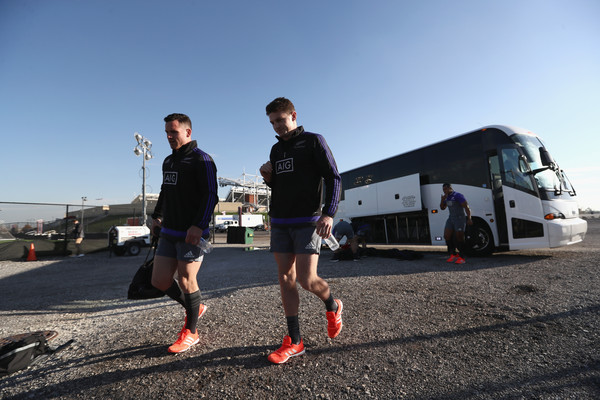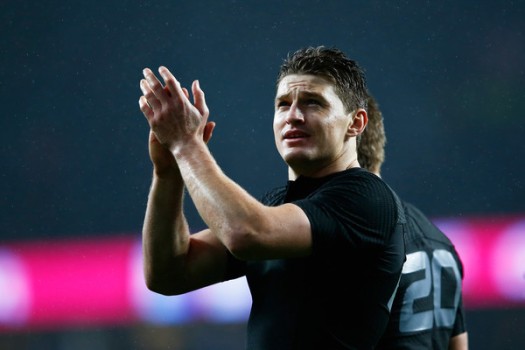
The first weekend of the 2016 Autumn Internationals gave some unexpected results. The first two games of the November campaign were really interesting. Just to remember, Wales was hosting Australia with New Zealand and the Ireland team facing each other.
In Principality Stadium, Wales did not manage to play their usual expansive game with the Wallabies having all the possession. The Waratahs first-five eighth Bernard Foley ran the show and the Welsh players were unable to find a solution to threaten the Australia team.
New Zealand was in Chicago, United States, playing in the Soldier Field against Ireland. To be honest, even before the start of the game, something was going wrong and it seems that Steve Hansen did not consider that this game could be very difficult for the All Blacks.
Following a miserable first-half, the All Blacks almost launched the perfect comeback but New Zealand was too short. That result was unexpected and obviously, there are many explanations which are justifying the fact that New Zealand did not win the other night.
Knowing the New Zealand mindset and that excellence which is targeted by the All Blacks coaching staff, the coaches and the players will probably have a hard look at themselves as a re-match is Dublin is looming in only two weeks of time after a game against Italy.
1. The second-row crisis : Terrible management
The New Zealand team started the Ireland game with only one capped second-row in their squad. Patrick Tuipulotu, from the Auckland Blues, started the game due to that second-row injury crisis. The two usual starters for that second-row position were unavailable.
First of all, Brodie Retallick was not playing in that game as he was out due to the concussion. Then, Sam Whitelock was unavailable against Ireland as well because he picked up a nasty ankle injury against the Australia players two weeks ago at Eden Park.
Also, the second-row back-up Luke Romano made himself unavailable for that game too. During the weekend, the assistant coach Ian Foster said to the media that Luke Romano had to come back to New Zealand for personal reasons, leaving the squad short of options.
It was very surprising to hear Ian Foster stating that no second-row cover would be called. The All Blacks environment was confident that the squad had enough depth to deliver in that area. The other two locks in the squad were uncapped : Scott Barrett and Vaea Fifita.
The lineout is one of the key areas of the game in rugby union and that was very strange that the New Zealand team did not call any cover. For example, the Crusaders lock Dominic Bird, who played for the team in the past, could have been called by the staff.
2. The squad management : Key players rested
There is a tradition in rugby union with giving game time to fringe players and uncapped players deserving game time during the Autumn Tests. With New Zealand playing Italy next weekend, we can ask whether it was the best idea or not to do that against Ireland.
Steve Hansen decided to give a rest to three key players who had performed consistently with New Zealand in the last few months. To begin with, fullback Israel Dagg was given a rest for this game and that was a bad decision given his ability to catch the very high balls.
Moreover, in the midfield, there was no continuity from the All Blacks coaching staff. During the 2016 Rugby Championship, many people were surprised with Anton Lienert-Brown, the Chiefs midfielder, called in the training squad rather than Seta Tamanivalu.
Anton Liernert-Brown delivered with an assist for his very first New Zealand cap against Australia at Westpac Stadium, Wellington. He performed consistently in Super Rugby and during that 2016 Rugby Championship so giving him a rest at this stage was just madness.
Finally, despite his place in the pecking order, that was very curious not to see Matt Todd in the starting XV or in matchday’s squad. Given his performance against Australia two weeks ago, his work at the breakdown and the number of turnovers won, it was a mistake.
3. The starting XV : Controversial selection calls
In the starting XV which was named by Steve Hansen on Thursday, some selection calls were clearly controversial. It has to start with the flanker Jerome Kaino switching at lock but the big problem was that he had never play in the second-row at Test level before.
Besides, we can argue that at least two players coming back in the starting XV were not really up for it. Back-rower Sam Cane started the game but he was coming back from a serious leg injury picked up during the 2016 Rugby Championship against Argentina.
Also, in the scrum-half position, Aaron Smith had a start after missing the last two All Blacks games after his indiscretion. Given how TJ Perenara performed during his absence, Steve Hansen thought that the pecking order was going to save the day but it was wrong.
The back-row combination can also be questionned with Liam Squire starting rather than Ardie Savea. Looking back at the June Tests and the Rugby Championship, Ardie Savea clearly performed better than Liam Squire but Steve Hansen seems to use him from bench.
Finally, in the midfield, Steve Hansen gave game time to George Moala who was just coming back from injury. On the bench, there was no Wyatt Crockett and much experience from a forward like him in the last stages of the game is what missed to the All Blacks.
4. The 80-minute performance : Not good enough
From a New Zealand point of view, that was a game of two halves with the first-half to be reviewed immediately. There was a lack of discipline which cost New Zealand exactly 3 tries. First, Joe Moody was on the bin for a dangerous tackle and it could have been worse.
During the Joe Moody’s yellow card, the All Blacks conceded 2 tries and 1 more try was conceded following a penalty given by the flanker Liam Squire for a high tackle once again. That is not possible to give away penalties like that at Test level if you want to win, then.
In the second-half, the New Zealand players gave everything to come back and it was not far from perfect. The back-three took their responsibilities but there was an area of the game when the All Blacks failed to deliver : the lineout and the accurate passing game.
As expected, the All Blacks had no lineout with a Jerome Kaino out of position and a Dane Coles completely lost with his throws. The two replacement props Ofa Tu’ungafasi and Charlie Faumuina both butchered a try scoring opportunity with some handling mistakes.
Then, the overall cover was not good enough with the New Zealand back-three unable to take those high balls. Clearly, there was a lack of time for this All Blacks squad to play their game. The All Blacks were always under pressure and the passing game was no good.
5. The Talking Points : Who stood out ?!
Despite that terrible and unexpected performance from the New Zealand team, there were several players who tried and played well. In the forwards pack, nobody reached their usual standards. Joe Moody was yellow carded and Owen Franks was often penalised too.
Hooker Dane Coles missed most of his throws with Patrick Tuipulotu struggling to have an impact and Jerome Kaino playing out of position. In the back-row, Liam Squire lacked discipline, Sam Cane was nowhere near his best and Kieran Read did not play very well.
The backline saved the day with their performance with TJ Perenara playing with speed and pace. Beauden Barrett had a better day from the kicking tee with Ben Smith scoring a good try and creating most of the try scoring opportunities for the New Zealand players.
Brought in the second-half, Aaron Cruden played pretty well but the wingers Waisake Naholo and Julian Savea did not bring their usual physicality. With the midield, Ryan Crotty had to come off with a leg injury and that was the same for George Moala, later.
Obviously, we can expect some turnover from Steve Hansen with Brodie Retallick and Sam Whitelock likely to come back even if Scott Barrett made a good debut. Ardie Savea could get his jersey back with Anton Lienert-Brown, Israel Dagg and Wyatt Crockett re-called.
Conclusion
There are a few explanations to this New Zealand defeat with first, a terrible management with the second-row injury crisis. The All Blacks were short of options and they though that they had a margin. Steve Hansen took a massive gamble there and it was not good.
Also, the squad management was sometimes really bad with the All Blacks coaching staff choosing to rest key players who were very important in the set-up. Playing without backs Anton Lienert-Brown and Israel Dagg penalised the New Zealand team in that game.
Controversial selection calls were made by Steve Hansen as he trusted some players just coming back in the team but they were probably not fit enough for that game. The 80-minute performance was inconsistent with a lot of indiscipline and many handling errors.
With the Italy game coming next weekend, Steve Hansen will probably make some turnover. The All Blacks coaching staff needs to have a look at their calls as their bench did not include Wyatt Crockett and his experience was missed in the last stages of the game.
Among the reactions to the All Blacks’ defeat, Sir Clive Woodward was very happy with the All Blacks “getting carried away with their own publicity”. I just want to remember Sir Clive Woodward that England won 1 World Cup. New Zealand actually won 3 World Cups.
Sometimes, it happens ! Go All Blacks !
Max.

